
Thyroxine sodium and levothyroxine sodium are both synthetic forms of the thyroid hormone used to treat hypothyroidism. While they serve a similar purpose, there are some key differences between the two.
Thyroxine sodium is the generic form of the thyroid hormone T4. It is often prescribed to replace the T4 hormone that the thyroid gland is not producing enough of. On the other hand, levothyroxine sodium is a specific brand name for the synthetic T4 hormone.
Both medications are generally well-tolerated and effective in treating hypothyroidism. However, some patients may respond better to one form over the other, so it is important to work closely with your healthcare provider to find the best treatment option for you.
Differences between thyroxine and levothyroxine

Thyroxine and levothyroxine are both medications used to treat hypothyroidism, but they have some key differences:
1. Chemical Structure: Thyroxine is also known as T4, and levothyroxine is the synthetic form of T4. Levothyroxine is the most commonly prescribed thyroid hormone replacement medication.
2. Brand Names: Thyroxine is available under the brand name Synthroid, while levothyroxine is available under various brand names such as Levoxyl, Tirosint, and Unithroid.
3. Potency: Levothyroxine is considered more potent than thyroxine, as it is the active form of the hormone that the body can readily use.
4. Absorption: Levothyroxine is absorbed more consistently and efficiently by the body compared to thyroxine.
5. Dosage Equivalency: Due to differences in potency, the dosages of thyroxine and levothyroxine are not equivalent. Patients may require different dosage adjustments when switching between the two medications.
It’s important to consult with a healthcare provider to determine the most appropriate thyroid hormone replacement option based on individual needs and medical history.
Similarities in thyroxine sodium and levothyroxine sodium
Thyroxine sodium and levothyroxine sodium are synthetic forms of the thyroid hormone thyroxine (T4). Both medications are used to treat hypothyroidism, a condition where the thyroid gland does not produce enough thyroid hormone.
Key similarities between thyroxine sodium and levothyroxine sodium include:
-
Both medications are available in tablet form for oral administration.
-
They work by replacing the deficient thyroid hormone in the body, helping to restore normal thyroid hormone levels.
-
Both medications are usually taken once daily in the morning on an empty stomach, at least 30 minutes before breakfast.
-
They are both considered safe and effective treatments for hypothyroidism when taken as prescribed by a healthcare provider.
In conclusion, while there are differences between thyroxine sodium and levothyroxine sodium, they share several key similarities in how they are used and their effectiveness in treating hypothyroidism.
Thyroxine sodium: Uses and benefits

Thyroxine sodium, also known as levothyroxine sodium, is a synthetic form of thyroid hormone used to treat hypothyroidism, a condition where the thyroid gland does not produce enough hormones. It is also used to treat goiter (enlarged thyroid gland) and certain types of thyroid cancer.
This medication works by replacing or providing thyroid hormone that is normally produced by the thyroid gland. It helps regulate energy levels and metabolism in the body. Thyroxine sodium is typically taken orally once a day, preferably in the morning, on an empty stomach.
- Benefits of thyroxine sodium:
- Improves symptoms of hypothyroidism, such as fatigue, weight gain, and cold intolerance
- Helps maintain normal metabolism and energy levels
- Aids in the treatment of goiter and thyroid cancer
- Can help improve mood and overall well-being
It is important to follow your healthcare provider’s instructions when taking thyroxine sodium and to have regular check-ups to monitor thyroid hormone levels in the body. Do not adjust the dosage without consulting your doctor.
Levothyroxine sodium: Dosage and administration
Dosage: The dosage of levothyroxine sodium varies depending on the individual’s age, weight, and the severity of the hypothyroidism. It is crucial to follow the prescription provided by the healthcare professional to ensure optimal results.
Administration: Levothyroxine sodium is typically administered orally, preferably on an empty stomach, at least 30 minutes before breakfast or 3-4 hours after the last meal. It is important to take levothyroxine consistently at the same time each day to maintain stable levels in the body.
Monitoring: Regular monitoring of thyroid function tests is essential to adjust the dosage of levothyroxine sodium as needed. It is crucial to follow up with your healthcare provider to ensure the medication is effectively managing your hypothyroidism.
Which one to choose: Thyroxine or levothyroxine?
Thyroxine sodium and levothyroxine sodium are both effective medications for treating hypothyroidism. Thyroxine, also known as T4, is a synthetic form of the thyroid hormone produced by the thyroid gland. Levothyroxine, also called L-thyroxine, is another synthetic form of the same hormone. Both medications work to replace the hormone that your thyroid gland is not producing enough of.
When deciding between thyroxine and levothyroxine, it’s essential to consider factors such as dosage, cost, and any potential side effects. While both medications are effective, some people may respond better to one type over the other. It’s essential to work closely with your healthcare provider to determine which medication is the best option for you based on your individual needs and medical history.
